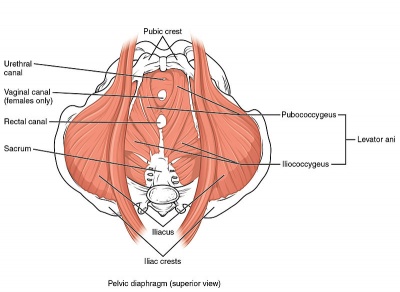Fecal Incontinence
- Page is currently under construction, please check back later for updates
- Specifically Fecal Incontinence associated with pregnancy and childbirth
Definition[edit | edit source]
The International Continence Society provides the following definitions of bowel incontinence:[1]
- Fecal incontinence (FI) is defined as the involuntary loss of feces (liquid or solid). FI is also referred to as accidental bowel leakage.
- Anal incontinence (AI) is defined as the involuntary loss of feces and/or flatus.
Etiology[edit | edit source]
For women who do experience FI or AI during pregnancy, pregnancy-specific contributing factors are not well understood. Normal physiologic changes of late pregnancy likely play a role, with increased transit time leading to altered stool consistency and delivery of contents to the rectum. Similarly, the increased intraabdominal pressure of the third trimester may contribute to incontinence for women with preexisting pelvic floor or anal sphincter dysfunction.
Childbirth itself may lead to incontinence through two major mechanisms: nerve and muscle injury. Passage of the fetal head through the pelvis may cause stretching and compression of the pudendal nerve, with demyelination and subsequent denervation for perhaps half of women delivering vaginally.[2][3]
Symptoms are more common during the postpartum period than during pregnancy. Two potential contributors to fecal incontinence and anal incontinence are damage to pelvic floor muscles and nerves, especially in women who experience an obstetric anal sphincter injury and/or women who undergo an operative vaginal delivery.
Clinically Relevant Anatomy[edit | edit source]
Please see the page "Pelvic Floor Anatomy," for further details regarding anatomy.
Clinical Presentation[edit | edit source]
Management/Interventions[edit | edit source]
Diet
Physiotherapist
Physician
Education
References[edit | edit source]
- ↑ The International Continence Society. Glossary. Available from: https://www.ics.org/glossary?q=fecal%20incontinence
- ↑ Sultan AH, Kamm MA, Hudson CN. Pudendal nerve damage during labour: prospective study before and after childbirth. BJOG: An International Journal of Obstetrics & Gynaecology. 1994 Jan 1;101(1):22-8.
- ↑ Allen RE, Hosker GL, Smith AR, Warrell DW. Pelvic floor damage and childbirth: a neurophysiological study. BJOG: An International Journal of Obstetrics & Gynaecology. 1990 Sep;97(9):770-9.







